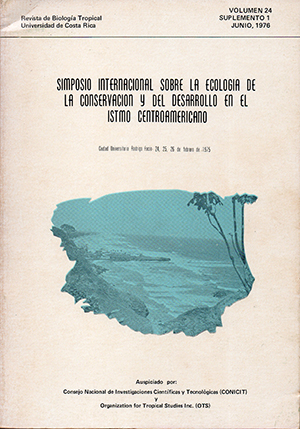Abstract
Exploitation of natural forests works well as long as they are reasonably accessible, adequate in size and produce materials desired by the society served. However, as natural stands are exploited and lands are diverted to nonforest uses, it is likely that without an input of technical silviculture, the natural development of secondary and residual forests will be inadequate. This is particularly true of the diverse tropical hardwood forests where often relatively few species and even fewer stems per hectare produce desirable material.
A serious technical problem presents itself in trying to match the complex forest production system with the utilization system. In early stages of exploitation of a natural tropical forest this match is likely to be poor as the forest conversion system is often simple with only one or two products and a small spectrum of industry, which usually is highly selective as to species, size and quality. Consequently a very small fraction of the trees and volume in a tropical hardwood stand has marketable utility. As long as there is surplus forest land, this situation can be tolerated. However, this utilization system of low concentration of marketable material per unit of area results in high operating costs in attempting to assemble meaningful quantities of material. This occurs even if the cost of the raw material itself is low. Furthermore, this system can result in depletion of useful material per unit area with time, as the unavoidable high grading that occurs commonly results in the replacement of usable forest stocking by unusable species, qualities, and sizes. As a result, the match between the forest production and utilization systems may worsen.
Unfortunately the classical extensive forest inventories often conducted have not always proved a useful tool in assessing the utility of natural tropical forest stands. The usual approach allocates most of the resources to counting and measuring standing trees without regard to utility. In later analysis stages the data may be adjusted to reflect merchantability but merchantability in this sense is often based on arbitrary classifications of trees into use and size categories that often bear little relationship to the conversion system in use. Furthermore, conversion system standards change and the above merchantability impositions in inventories have generally failed to loo k at merchantable volumes in terms of flexible alternatives. As a result, the data from such inventories can be dangerously misleading in guiding planning discussions.
This paper presents some preliminary results from a study aimed at providing a loo k at the match between the forest production and conversion systems when different sets of utilization standards are imposed on the forest. The results focus on three Costa Rican forest situations: the mixed natural forest at La Selva, dominated by Gavilán (Pentaclethra macrolaba) ; the mixed natural forest along the Atlantic coast dominated by Cativo (Prioria copaifera) and Cedro Macho (Carapa guianensis); and pure even-aged plantations. The mixed forests contain many trees of unusable species or qualities, such that over-all usable productivity is quite poor. This situation may be improved by either simplifying the forest structure by silviculture to favor the more usable species and/or increasing the complexity of the conversion system to enable a greater use efficiency of currently desired species and to include currently unused species.
References
Burwell, B.B. 1974. A study of stand structure, spatial wet premontane forest of La Selva, Costa Rica. University of Washington, College of Forest Resources. Unpublished Report. 50 pp.
Catinot, R. 1972. Biological and economic opportunities and Iimitations to the manipulation of the tropical forest ecosystem. VII World Forestry Congress. Buenos Aires, October 4-18, 1972.
González, R. 1972. Inventario forestal, Barra del Pacuare, Limón, Costa Rica. Ministerio de Agricultura y Ganadería, Dirección General Forestal, San José, Costa Rica. 17 pp. (mimeografiado).
Hartshorn, G. S. 1972. The ecological Iife history and population dynamics of Pentaclethra macroloba, a tropical wet forest dominant and Stryphnodendron excel-sum, an occasional associate. Ph.D. Thesis, College of Forest Resources, University of Washington, Seattle. 119 pp.
Johoson, P., & R. Morales 1972. A review of Cordia alliodora (Ruiz & Pav.) Oken. Turrialba, 22: 210-220.
Machado, S., & W. Albertin 1973. Algumas relacoes dasometricas importantes em um bosque secundario tropical. Turrialba, 23: 192-199.
Madriz Vargas, A. 1973. In World Wood Review 1973. World Wood 14: 65-67.
Petriceks, J. 1956. Plan de ordenación del bosque de la Finca "La Selva ". M. Agr. Thesis, Instituto Interamericano de Ciencias Agrícolas, Turrialba, Costa Rica. 176 pp.
Takeuchi, K. 1974. Tropical hardwood trade in the Asia-Pacific Region. World Bank Staff. Occasional Paper No. 17. The John Hopkins Univ. Press. 90 pp.
Tschinkel, H. M. 1966. Annual growth rings in Cordia alliodora. Turriabla, 16: 73-80.
##plugins.facebook.comentarios##

This work is licensed under a Creative Commons Attribution 4.0 International License.
Copyright (c) 1976 Revista de Biología Tropical


